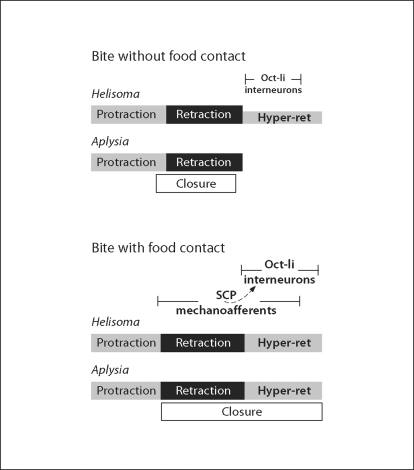Fig. 5.
Schematic summary of proposed actions of OA-li and SCP-li neurons. This diagram is simplified to emphasize the roles of the neurons considered in this article. The polymorphic feeding motor systems of Helisoma and Aplysia can generate many variants of the feeding sequences depicted. Upper panel: during a bite without food contact, SCP-li RMs (B101 cluster neurons of Helisoma and RM cells of Aplysia) receive minimal exteroceptive stimulation. Under these conditions, OA interneuron firing (smaller font) does not evoke maximal hyperretraction in Helisoma and may not occur in Aplysia. In this sequence of actions, referred to as ‘biting’ in Aplysia [see Cropper et al., 2004], closure of the radula, which can be initiated by several pathways [see e.g. Plummer and Kirk, 1990; Evans and Cropper, 1998; Jing et al., 2004], begins near the peak of protraction and is primarily associated with the retraction phase. Lower panel: when a bite does encounter food or exteroceptive resistance, the SCP mechanoafferents are activated during the late phase of protraction. In Helisoma, they act in an ‘influential’ fashion on the OA-li interneurons (dashed curved arrow), increasing the intensity and duration of their firing (bold text, compare to upper panel). In Helisoma, this causes a stronger and more prolonged hyperretraction phase. We propose that the RM cells of Aplysia will similarly promote strong activation of the OA-li neurons and enhanced hyperretraction movements. The well characterized direct actions of the Aplysia RM neurons on radula closer motor neurons [Rosen et al., 2000a; Shetreat-Klein and Cropper, 2004] will contribute to coordinating radula closure with the prolongation of radula retraction.

